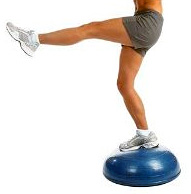Unlock the Power of Your Workforce
Maximize Your Team's Potential with our Human Performance Solutions
Key Components of Balance – Slips, Trips and Falls Prevention
Slips, Trips and Falls (STF) are the number one cause of industry accidents making up 25% of reported injury claims per year. OSHA states that STFs are also the second leading cause of accidental deaths at 15%, preceded only by motor vehicle accidents. While the statistics look bad, the good news is that most of these accidents were preventable. There are measures we can take to decrease our personal risk of a STF.
Situational Factors
Situational awareness is a key factor in prevention. Be sure to wear proper fitting footwear, remove tripping hazards, using caution on wet or muddy surfaces. Granulated (sandy) surfaces, floor mats and polished floors are also contributors of STFs. Constantly be aware of your surroundings, slow down, use caution and avoid injuries.
Physical Factors – Building Balance. The primary physical factors contributing to STFs are musculoskeletal, visual and vestibular. These factors contribute to a complex balance system that can easily be taken for granted. This system and its individual components may also be improved upon with general awareness and practice.
Musculoskeletal. The musculoskeletal system is a combination of the body’s muscles and bones and connective tissues such as ligaments and tendons. Proper conditioning of the musculoskeletal system leads to drastic improvements in balance, coordination that prevent the occurrence of STFs. Injury or certain medical conditions such as diabetic neuropathy can significantly increase the risk of STF due to declines in balance. Test your balance by moving from a regular, two foot stance to a single leg dominant stance and progressing to a single leg stance is an excellent way to improve the musculoskeletal component of balance. Attempt the following balance drill to test for a baseline of musculoskeletal stability by holding a single leg stance for 10 seconds. Attempt to stay perfectly still and gauge your baseline by how much your body sways away from a central position during the 10 second period. Repeat test on both legs, your baseline will likely be different on each side.

Vestibular. The vestibular system is a network of canals and chambers in the inner ear. These canals and chambers contain fluid. Subtle shifts in these fluids send signals to our brains about our head and body’s positioning. The vestibular system is a huge silent contributor to balance. Anybody who has ever had a severe ear infection or issues with vertigo can attest to the impact of the inner ear on balance and STFs. To test the impact of your vestibular system on your balance repeat the above single leg stance balance test, eyes closed, tilting your head side to side. Increases in sway are due to shifts in the inner ear fluid. Be mindful of the impact of hydration on these inner ear fluid levels. Dehydration can cause rapid declines in balance and coordination increasing your risk of a slip, trip or fall.
Takeaways. Decrease your risk of a STF by being aware of your baseline and potential hurdles involving the key components of balance: musculoskeletal, visual and vestibular. Practice these balance drills in stable safe conditions. For example, while brushing teeth take single leg stance. Increase the challenge by removing visual input and moving your head side to side to shift the fluids in your ears. Challenge yourself to take personal responsibility for the health of your individual balance components and reduce your risk of injury due to slips, trips or falls.
About SiteWell Solutions
SiteWell Solutions is committed to supporting business and organizations with health, wellness and injury prevention services. A healthy workforce is proven to be more engaged, productive and happier. It is our mission to deliver these outcomes to every organization we serve. Our services include onsite and virtual corporate wellness programs, industrial athlete training, injury prevention services, chronic disease management, employee resilience support services and much more. Contact info@sitewellsolutions.com today to find out how we can optimize your organization.
Health tips in your inbox
Our Services
Get in touch
Call us at +1 (321) 300-4338
Terms & Conditions | SWS App Privacy Policy
© SiteWell Solutions | 2025 All rights reserved
Site design by WebXDesigner.com